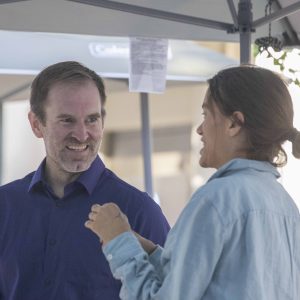
George Lakoff, a professor of Cognitive Science at UC Berkeley, is famous for his research on what he calls the “conceptual metaphor”—the deep, and often unnoticed, metaphors through which we think and understand the world around us—oftentimes without even realizing it.
For example, when we say, “Halloween is coming,” there’s an underlying spatial metaphor at play; when we say “he won the debate,” or “he couldn’t defend his point,” or “he made a weak argument,” there’s an underlying conceptual framework of discussion as competitive warfare, with winners and losers, and your personal status as dominator or dominated as the thing that’s most at stake in the act of discussion.
The pedagogical model we use at DRBU—“Shared Inquiry”—relies on a very different underlying metaphor.
One of the most powerful and commonplace metaphors in education that we rely on in conventional usage (that actually gets in the way of learning) is known as the “conduit metaphor”: the idea that knowledge is contained in books—and that in reading a book, the knowledge within it “is transmitted” to the reader; in classes, the knowledge that teachers have “is transmitted” to students. This is, sadly, just a metaphor, and the reality is more complex.
Knowledge is produced by and within the reader, or the student, as he or she interacts with and attempts to interpret the code within the book, or the professings of a professor. There is actually no channel—no “conduit”—through which knowledge and understanding can be poured, transmitted from one vessel to another, or reproduced as a perfect copy. Instead, every bit of knowledge is hard-won and has to be created by the student, through interaction with the object of inquiry, attempting to decipher and interpret the form that the knowledge of its producer was translated into, as a blueprint for future decipherers to engage with and try to construct their own understanding on the basis of.
The idea of a perfect copy is a myth. There is no knowledge “in books” apart from the knowledge produced in the mind of the reader through the act of reading, probing, testing, and interacting with a text. Doing this together in a relaxed and intimate, small classroom environment produces what at DRBU we call “shared inquiry,” putting students, text, and instructors in a dynamic, interactive relationship in the shared pursuit of insight, knowledge, and new and deeper understanding.
To quote our catalog:
“The text, teacher, and student form a triangular relationship of inquiry where authority rests with not one exclusively but through all in concert, even at times in tension. This pedagogy depends a great deal on the initiative and activity of the students for learning. With ardent and engaged students, the classroom atmosphere becomes catalytic, not didactic; teaching aims at drawing out rather than pouring in.”
In shared inquiry, we strive for catalytic learning—individual, or in the best case, collective “aha moments”—rather than didactic learning. We strive to think about, but also to think with, the texts we read and certainly never to tell you what to think. We consider the questions they raise, unpacking their positions, and our own, through the act of discussion. The act of reading and discussion should reveal the reader as much as it reveals the text.
Class discussions in the shared inquiry format therefore begin with a question, which the class takes up for shared consideration. The aim of discussion is to together arrive at a clearer understanding of the text than what we arrived with, from our isolated reading. We don’t debate, or seek to impress, or dominate, but to better understand, and to probe together. One person’s insight or question perhaps sparking an insight, or revealing a previously unconsidered angle for someone else.
So when we’re discussing, if you have an insight into the text, or question at hand, share it. Your insight will shed light on the text for everyone else. There’s no other light, actually—because the text is only raw materials for making a fire. It’s us who have to bring the sparks. Ideally, these arise in the course of our discussions. And together we can fan them into flames.